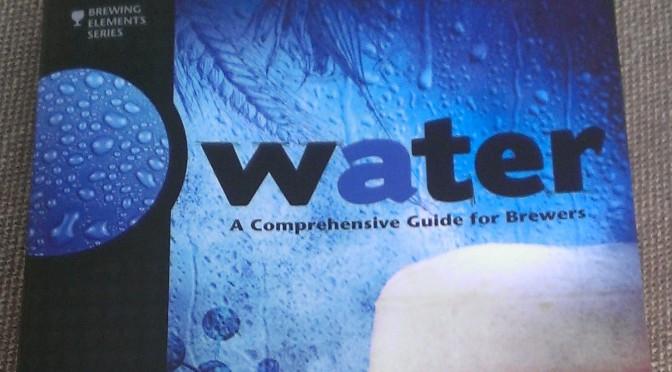Water, huh! What is it good for?
Difficulty: 
Time Required:
As long as it takes you to read this post.
Affiliate Links
Water:
Back in November, I had the opportunity to see John Palmer give a seminar on water at Great Fermentations. He was essentially on tour to promote his new book he co-authored with Colin Kaminski simply called, Water. So the day I went to the seminar, there were tornado warnings. As I write this, all water outside is in the form of ice. Hopefully we’re at the tail end of the “Polar Vortex”. A theme of things spinning, kind of like your head when you learn about water.
This isn’t a review of the book, or an in depth look at the chemistry of water, but just some of my musings on the importance of water in brewing. Water has to be one of the most intimidating, mysterious, confusing and scientific parts of brewing. To the beginning brewer, learning about it could confuse them enough that they think they’ll never brew good beer.
As you would imagine, at the start of his presentation I was completely engaged in what he was saying. He had some entertaining slides correlating Lego superheros to certain elements of water. I was understanding what he was throwing down. I saw some charts and graphs that I understood, as any self-respecting engineer should. Then we got to the chemistry balancing equations. That’s when my eyes start to gloss over. I’m reminded of the time in college when my wife (then girlfriend) said to me”your math is hard, it has letters”. She was with me at the seminar and was following for a while and then got lost. I never really enjoyed chemical formulas and electron counting and balancing equations.
So is understanding water necessary? Yes!
Is being a amateur chemist a requirement? No!
Is there an in-between that will get me producing good beer with minimal knowledge? Yes!
First order of business is to simplify the intimidation out of the whole water thing.
In my opinion, this should be your priority level as you progress.
Starting out (Extract recipes):
Just go with tap water or water from the grocery store (see note at the end of this section). I always went with Ice Mountain spring water, simply because I could actually taste a difference in waters and I liked it the best. During this stage, I was always on the hunt for the water to go on sale. For some reason, the online ads for my local grocery stores would not mention when it was on sale, nor were the sales on water the same at each location. My benchmark price was $1/gallon, so if I saw it for that price, I was essentially clearing the shelves like some mad extreme couponer. When I was really lucky, I would find the 2.5 gallon containers on sale and reduce the amount of plastic I was discarding each brew session. I’ve never used just straight tap water, but I’ve tasted beers from people who’ve made beer with unadulterated city tap water and never had any complaints. DO NOT however use softened water.
At this stage, don’t worry about treating the water. Just brew and try to work on all of your other techniques.
*Recent reading/listening I have been doing indicates that with extract brewing, you might actually be better off with reverse osmosis (RO) or distilled water. The theory is that the maltster making the extract has already created the proper water profile. When the extract is concentrated, the water goes away, but the minerals are still there, so when you are adding it to your water, you are then getting those minerals in your brewing water. This is backed up in a recent BeerSmith podcast with Colin Kaminsky and John Palmer.
Beer Brewing Water with John Palmer and Colin Kaminski – BeerSmith Podcast #70
Intermediate (Extract with steeping grains or all-grain):
This is where you want, at minimum, some sort of pH adjustment. I use and recommend food-grade phosphoric acid. Your LHBS should have it available, typically in 75-85% strength (ie 75% acid, 25% water). I get it in a 4 fl.oz. container, which at an average of approximately 1 tsp per 5 gallon batch, it is good for about 24 batches. FYI, I’m still learning and tuning my adjustments. The much maligned colorpfast strips should suit you just fine at this stage. Unless you just want to spring for the electronic pH meter. As much as I love the gadgets, I opted for the strips first and have only recently purchased a pH meter.
Some details that emerged as I got more into water adjustments:
- Yes the colorphast strips are off by some amount (reports up to 0.3 pH) and the judging of color feels like you are being subjective, but they served me well and in my experience are very close to the digital pH meter.
- The most accepted method is to measure the pH of the mash about 20 minutes after dough-in, but remarkably, the amount of acid I was adding was within some small percentage of what I was adding when I was (incorrectly) measuring pH with the room temp water before heating up to strike temp. Oh, well. Dumb luck, considering I now know that your malt bill works in conjunction with the water chemistry to alter pH.
- I am currently into evaluating different water chemistry spreadsheets to see which ones are most accurate at prediction. Some of them say if you don’t know the pH of your water, just assume a pH of 8. I got a fancy electronic pH meter to tell me that my water was 7.95.
- Oh, get a small sample of the mash water and cool it down before you measure the mash pH. Unless you are using the strips, which in my usage, seem unaffected by temperature.
Advanced:
This is where you will be making changes that only people beyond your friends and family will notice the difference. I’m talking about beer judges and those with the refined tastes. I once heard Gordon Strong say on a podcast about water that water chemistry is the difference between a 30 and a 40 in competitions. I do not feel I am at this stage yet, but what I keep telling myself is that pH adjustment alone is 75% of what matters in water adjustment. In another podcast Jamil Zainasheff made a comment that after all of his work in understanding water, he was unsure which component of water adjustment was the most effective and wondered if it was mostly the pH adjustment. If you do get to this stage, salts and other water additions are necessary to eek the last bit of perfection out of your recipes and really highlight your ingredients.
Conclusion:
To paraphrase something John Palmer said at the water seminar: Just like how salt, pepper and other spices really bring out the flavor in foods, the same can be said about the additions and adjustments to brewing water.
I am currently experimenting with the various software spreadsheets available to add the theoretical adjustment ingredients and be done with it. I’m hopeful this is doable and I will be checking back in with this theory at some point. Of course you still want to measure again to make sure your additions had the intended effect, but it would be nice to have a predictable method. In the BeerSmith podcast referenced above, Colin Kaminski even notes that he has it down well enough that he’ll make the adjustments to the water before hand and knows what to expect. If it doesn’t turn out like he preferred, he brews again and essentially renames the alternate batch as a different beer.
I’ll go over water reports, filtering, measuring and adjusting water and review various software tools used to predict adjustments in future posts.



